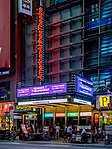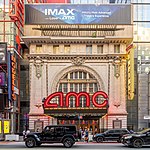Liberty Theatre

The Liberty Theatre was a Broadway theater from 1904 to 1933, located at 236 West 42nd Street in New York City. It was built by the partnership of Klaw and Erlanger.From 1933 until the late 1980s the Liberty operated continuously as a movie theatre. In 1992 the then vacant theatre was purchased by the City of New York along with many other properties as part of the New 42nd Street renovation project. In 1996 it was used for a staged reading of T. S. Eliot's poem The Waste Land, with actress Fiona Shaw, directed by Deborah Warner. The New York Times review described the theater as "derelict". The facade of the Liberty theater was later absorbed into Ripley's Odditorium, which is part of the Forest City Enterprises entertainment complex.In 2011, renovations were completed and the former Liberty Theatre auditorium was converted for use as a Famous Dave's restaurant. The main auditorium space later became a rental event space, with the restaurant portion along 42nd Street operating as the Liberty Diner.From March 2015 to November 2015, Cynthia von Buhler's Speakeasy Dollhouse: Ziegfeld's Midnight Frolic was staged as an immersive play in the theater. The story investigates the death of silent film star and Ziegfeld Girl Olive Thomas. Barring this performance, the space has sat vacant, the Liberty Diner (and thus access to the auditorium space) having been closed since 2015 when the operators lost the lease.
Excerpt from the Wikipedia article Liberty Theatre (License: CC BY-SA 3.0, Authors, Images).Liberty Theatre
West 42nd Street, New York Manhattan
Geographical coordinates (GPS) Address Website Nearby Places Show on map
Geographical coordinates (GPS)
| Latitude | Longitude |
|---|---|
| N 40.75658 ° | E -73.98826 ° |
Address
Madame Tussauds New York
West 42nd Street 234
10036 New York, Manhattan
New York, United States
Open on Google Maps










